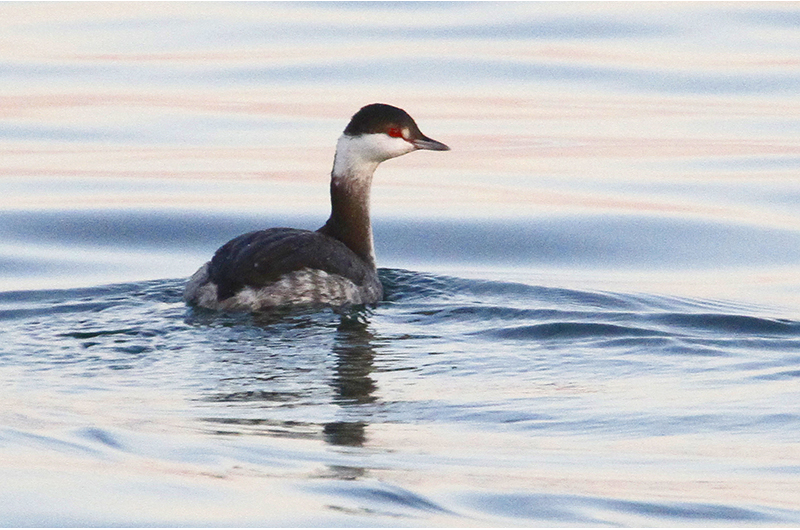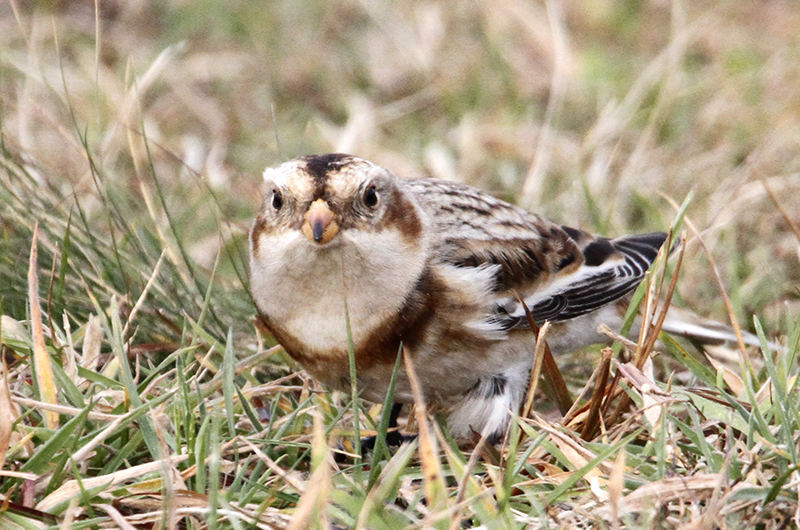The season for southbound migrants continues, perhaps accelerated due to the recent winter-like weather at the end of October. Six species that are winter residents arrived this week, with more on the way.
Tony Lima wins the “What is it doing there?” contest with his sighting of the first of the season snow bunting on the Oak Bluffs Steamship Authority dock on Oct. 31. A beach is a much more usual and suitable place for this species, and Rick Dwyer spotted a flock of them on Norton Point Beach the same day. Olsen Houghton also spotted snow buntings at State Beach that day. While at State Beach, he also spotted the first horned grebe of the season. Allan Keith, Susan Whiting and Jeff Muldaur also observed this species off Squibnocket that day. Bob Shriber joined this crew at the Gay Head cliffs, where they spotted three Lapland longspurs. Bob Shriber spotted some harlequin ducks there on Oct. 26, and all four birders got to see them on Oct. 31. Bob Shriber also spotted a northern gannet there on Nov. 1 and a long-tailed duck on Oct. 28.
There are nine late lingering migrants this week that are unlikely to stay for the winter. Susan Whiting sighted females of the following three species: orchard oriole on Oct. 19, and a purple finch and a red-winged blackbird on Oct. 23. The latter sighting is unusual in that lingering blackbirds are usually male. The next day she spotted a lingering osprey over Tisbury Great Pond. On Nov. 1, I joined the troika of Nancy Weaver, Margaret Curtin and Luanne Johnson at the Head of the Lagoon, where our most interesting lingering birds were a rose-breasted grosbeak, ruby-crowned kinglet, and red-eyed vireo. Bob Shriber also spotted a red-eyed vireo at the cliffs the same day. Olsen Houghton spotted a semipalmated plover at State Beach on Oct. 31. And finally, Kathleen Kinsman and Susan Whiting have spotted individual grackles.
Transient migrants are still passing through. The crew of Susan Whiting, Allan Keith, Jeff Muldaur and Bob Shriber spotted American pipit, clay-colored sparrow, white-crowned sparrows (five of them), and a western palm warbler at the cliffs. At Squibnocket on Oct. 28, Bob Shriber added field sparrow and ruby-crowned kinglets. The latter species was also spotted by Luanne Johnson’s crew at the pumping station on Nov. 1. Hans Goeckel reports finding a Kestrel hovering over the Farm Institute field on Oct. 26.
Bird Sightings
I will take a chance and predict that the irruptive pine siskins and red-breasted nuthatches will stay here through the coming winter. Both are still around in sizeable numbers and are reported by multiple observers. Holly Mercier, Thomas Mayhew, Debbie Lobb Athearn, Cynthia Bloomquist, Laura Lenihan, Sally Cook, Susan Whiting, Susan Straight, Bob Shriber and myself have all spotted siskins, while Sally Cook, Susan Straight, Luanne Johnson, Nancy Weaver, Margaret Curtin and myself have all reported the nuthatch. The latter species seems to be just about everywhere there are pine trees. Danguole Budris was parked next to pine trees at Wasque Reservation when one perched and flew around (outside) her car on Oct. 31.
Large flocks of fish crows are back scavenging for food in downtown Vineyard Haven and Oak Bluffs, where any food left on the ground will be consumed. Multiple observers (Nancy Weaver, Vasha Brunelle, Elizabeth Toomey, Penny Uhlendorf, Patsy Donovan, Sharon Simonin and myself) have observed these flocks. These crows are here throughout the day and night, as neither Penny Uhlendorf nor David Stanwood have seen the winter-time commuter crows that roost on the Vine
yard while spending the day on Cape Cod. these crows — both American and fish — will fly over their houses daily on their dawn and dusk commutes.
Speaking of corvids, John Nelson was excited to find a raven at the Farm Institute on Oct. 31, as well as a peregrine falcon. Others spotting ravens this past week include Elizabeth Leo, Sioux Eagle, Nancy Jephcote and Albert Fischer.
Winter waterfowl are becoming more abundant. In addition to the first sightings of the season mentioned above, the species already here are becoming more abundant. Bufflehead and red-breasted mergansers can now be found on most of our larger brackish ponds, as reported by John Nelson, Martha Moore, Walt Looney, Olsen Houghton and myself. Common eiders and all three species of scoters — white-winged, black and surf — can regularly be seen flying or swimming offshore in medium to large flocks. Martha Moore spotted hooded mergansers on Middlepoint Cove. And I counted 115 brant in Ocean Park — smaller cousins of the Canada geese that also are found there in large numbers.
Maggie Bresnahan, Cynthia Bloomquist and John Nelson all report their first dark-eyed juncos of the season at their feeders this week.
Finally, for those of you wondering how long your hummingbird feeders should remain outside, Sarah Lolley reports “A lone hummingbird appeared at our window box on Oct. 27, feeding at the still flowering impatiens plants. A welcome surprise!”
So a few may still be around as they head to warner southern climes. Photographs of them are almost always required to identify them as differences between various species are subtle and we cannot assume they are ruby-throated at this time of the year.
Please email your sightings to birds@mvgazette.com.
Robert Culbert is an ecological consultant with Nature Watch LLC living in Vineyard Haven.










Comments
Comment policy »